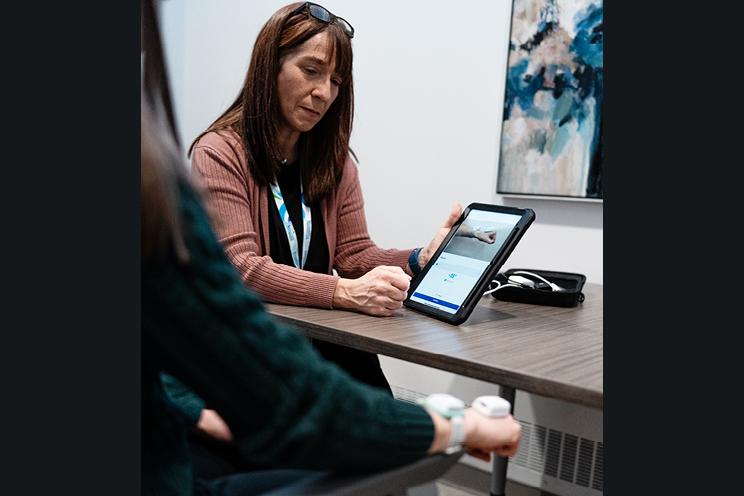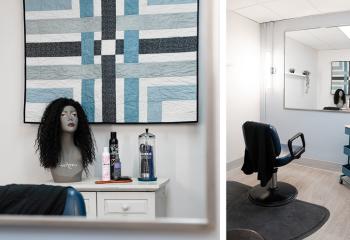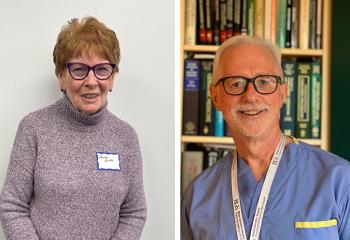
QEII occupational therapist Lindsay Edwards (left) assesses a patient’s progress using Tenzr wearable sensor technology. The device tracks and provides feedback on a patient’s movement quality and frequency. UNCHARTED.MEDIA
Donor-funded space and technology are enhancing rehabilitation care
Relearning and regaining skills for independence are the goals for every patient at the QEII’s Nova Scotia Rehabilitation and Arthritis Centre.
Now, thanks to donor support, patients will have access to a brand-new space, an Upper Extremity Performance Centre, and modern technology to support their journey to independence.
The Upper Extremity Performance Centre will be equipped with digital tools to help patients recover and strengthen hand, arm, and shoulder skills needed for activities of daily living — like eating, grocery shopping and meal preparation.
Natalie Thornley, a QEII occupational therapist, explains that technology like virtual reality and wearable sensor devices empower patients to be more independent, self-direct their care and stay engaged in therapy.
“With access to this technology and new space, patients can guide and go through their own exercises in addition to their one-on-one sessions with their therapist, which means they can spend more time practising and making progress,” she says.
Incorporating virtual reality into therapy provides additional opportunities for repetition, feedback, and task-oriented training that keep patients engaged, interacting with virtual activities that are meaningful to them.
The wearable sensor technology has already been a game-changer for patients and clinicians. Worn on the hand and wrist like a fitness tracker, it provides feedback on movement quality and frequency. Patients get real-time feedback, and clinicians can adjust treatment plans based on the data.
Natalie says digitizing home exercise programs for outpatients helps them stay engaged in therapy even after leaving the rehabilitation centre.
“It’s a major advancement. It helps patients stay on track with their rehabilitation goals and allows clinicians to make informed decisions about their care outside of a clinical setting,” says Natalie.
For inpatients using wearable sensor devices, iPads will be set up in the Upper Extremity Performance Centre as a spot for them to check their progress and do their exercise in a group setting.
Improving patient outcomes
As the province’s largest and most specialized rehabilitation centre, patients arrive following a life-changing illness or injury like a stroke, amputation, or spinal cord injury. Inpatients spend several hours a day receiving therapeutic care, with an additional 30,000 outpatient visits happening annually. And the donor-funded technology is playing a critical role in their care.
The new tools are clinically proven to improve patient outcomes compared to traditional therapies. Even minor improvements in function translate into significant strides in independence.
The Upper Extremity Performance Centre, set to open later this spring, will be a major part of patient therapy. About 40 of the 66 inpatients will use the lab’s technology four times a week, while 30-40 outpatients will visit weekly.
“The refreshed, modern, bright space can boost motivation and mood,” says Natalie. “Being in a space created with intention will inspire and encourage patients. It’s a more comfortable spot to spend time.”
The power of collaboration
The space will also foster collaboration between patients and clinicians, united by shared goals — something they share with the 15 donors who fully funded the Upper Extremity Performance Centre.
The lab and technology were made possible by the QEII Foundation’s Leadership Giving group. This newly created group brings donors together to fully fund one project each year, ensuring their collective generosity has a tangible impact on an important healthcare priority. Each donor contributed $5,000, with the J & W Murphy Foundation matching every gift to reach the $150,000 project goal.
Dave Shea, chair of the Leadership Giving group and executive vice president of Kraken Robotics, is thrilled with what the group has accomplished.
“Health care is something that affects everyone at some point,” he says. “The group brings together people passionate about supporting the healthcare system and collectively funding a project that might not be possible to do alone.”
“As soon as the space opens, we can see our impact on patients directly. It’s very satisfying to know how imminent it is and that it won’t take years to start making a difference in people’s lives,” he says.
QEII Foundation donors have a long history of enhancing rehabilitation spaces. In 2016, donor funding made the Grace Hansen Therapeutic Pool possible. And in 2018, two donor-funded Independent Living Simulation Suites opened, providing safe spaces for patients to practise everyday skills before returning home.
The Leadership Giving group’s generosity means there’s one more life-changing space for patients. Dave hopes that by showcasing the success of funding the Upper Extremity Performance Centre together, others will be inspired to get involved.
For Natalie and her colleagues, they’re filled with gratitude that the Leadership Giving Group chose to support rehabilitation care.
“It’s astonishing to have people interested in our area. As a team, we are so passionate about rehabilitation; it’s an important part of health care. It’s nice that other people see that potential and want to support the care that is delivered here.”
Visit QE2Foundation.ca/upper-extremity-lab to learn more.


